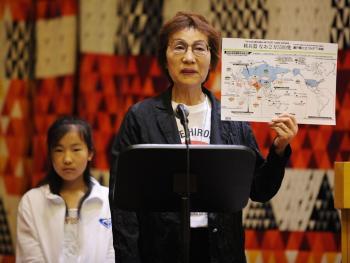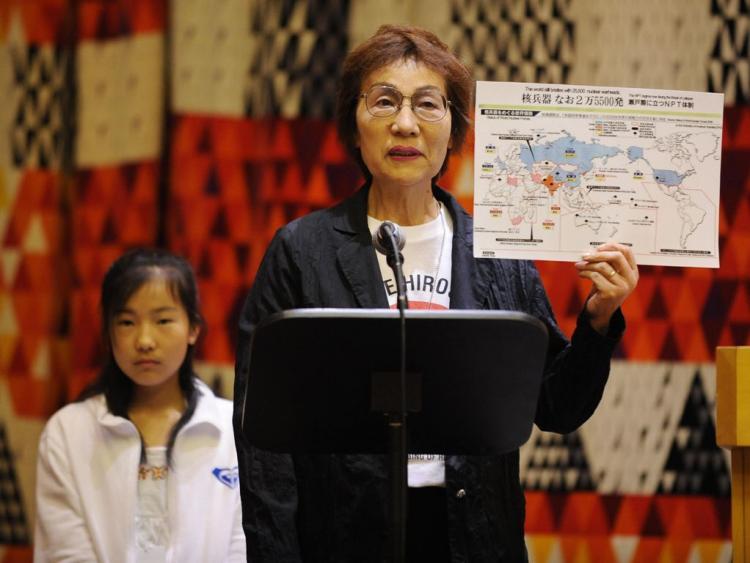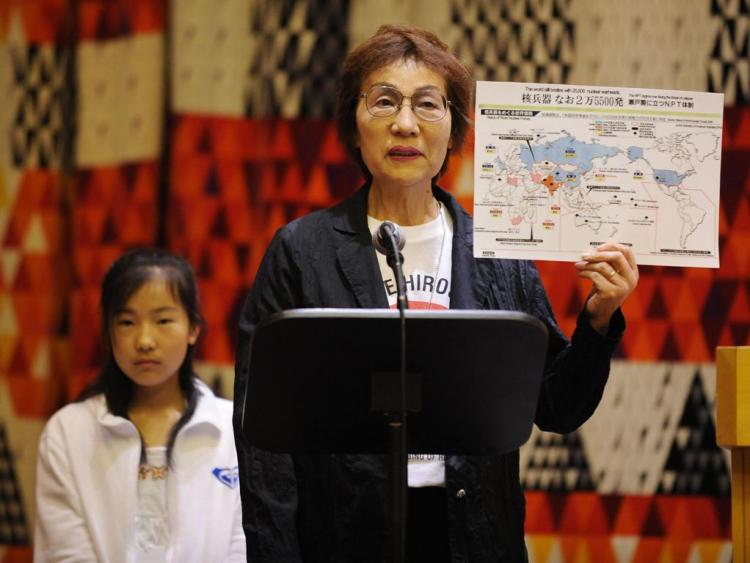Leaders in the nuclear disarmament movement spoke with urgency and optimism at a Toronto conference last weekend about the need to eliminate all nuclear weapons.
“It’s been urgent since the first nuclear bomb exploded, and it hasn’t stopped being urgent,” said Metta Spencer, who organized the “Zero Nuclear Weapons” public forum on Nov. 13 and 14 at Toronto City Hall.
Ms. Spencer said over 23,000 nuclear weapons still exist today, as noted by U.N. Secretary-General Ban Ki-moon in his introductory remarks to a lecture in Geneva last month.
Many are on missiles that could be launched within 15 minutes, said the editor of Peace Magazine and former sociology professor, adding that there is a risk of firing them by mistake and of terrorists acquiring the materials to build nuclear bombs.
As well, “more and more countries will want to get nuclear weapons of their own if we don’t fulfill the terms of the agreement . . . we began many years ago and move to real nuclear disarmament,” she said, referring to the Nuclear Non-Proliferation Treaty (NPT) that came into force in 1970.
At that time the world had five nuclear weapons states (NWS): the U.S., Soviet Union, U.K., France, and China.
Under the treaty, the five NWS agreed to move toward complete disarmament, while the non-nuclear weapons states (NNWS) promised not to acquire nuclear weapons. Another provision was that all states would cooperate in the field of peaceful nuclear technology, such as for health, energy, and other uses, and all NNWS would be given access to that technology.
Ms. Spencer said the problem is that the five nuclear powers have reduced the number of arms but are by no means close to eliminating them. Thus other countries hold the view that they should have the right to acquire nuclear weapons.
Today 189 countries are party to the treaty. Iran, one of the parties, has recently been much publicized as a nuclear threat. Outside the treaty, India, Israel, and Pakistan have developed nuclear weapons, and North Korea has nuclear explosive capability.
Ms. Spencer expressed optimism about the current climate for ridding the world of nuclear weapons.
“The beautiful part is we have a really committed U.S. president who wants to move towards complete abolition of nuclear weapons,” she said, citing his speech in Prague in April outlining this vision.
Other forum speakers agreed.
Douglas Roche, a former Canadian MP, senator, and ambassador and a prominent advocate for nuclear disarmament, noted that President Obama moved the process forward on Sept. 24 by convening an unprecedented Summit of the U.N. Security Council.
Mr. Obama and Dmitry Medvedev, President of the Russian Federation, set an ambitious action plan to reduce nuclear arsenals and delivery vehicles. This is significant since the U.S. and Russia own about 95 percent of the world’s nuclear weapons, said Ms. Spencer.
Mayor Tadatoshi Akiba of Hiroshima participated by video-conferencing from Japan. He is also the president of Mayors for Peace, a registered U.N. NGO that has 3,241 members cities in 134 countries and regions, including 74 Canadian and 149 U.S. cities.
The group proposed an action plan last year as an addendum to the NPT, called the “Hiroshima-Nagasaki Protocol,” aiming to achieve total nuclear weapons elimination by 2020.
Mr. Akiba said this is “technically and physically feasible” and highlighted the need to “work at both government and grassroots levels” to support this effort. One ally is the U.S. Conference of Mayors, an association of 1,200 cities with populations of 30,000 or more that has played “an extremely important role in changing American society since the 1930s.”
“To generate heat on politicians, people themselves have to be moved,” agreed Mr. Roche.
“Nuclear disarmament campaigners must first of all have confidence in ourselves, knowing that we are on the right side of history and that historical momentum towards the abolition of nuclear weapons is indeed building up,” he said.
“Public opposition to nuclear war,” added Mr. Roche, “has already on numerous occasions caused governments to step back from the brink.”
He called for a Nuclear Weapons Convention as a legal basis for phasing in concrete steps in a defined timeframe toward eliminating nuclear weapons safely and securely.
Ms. Spencer said Canada has an important opportunity at the U.N. Conference on Disarmament in Geneva to support negotiation of a Fissile Material Cut-off Treaty. This treaty would stop production of uranium and plutonium in the form that can be used in nuclear weapons.
As a member of the North Atlantic Treaty Organization (NATO), Canada should also advocate for change to NATO’s policy of relying on nuclear weapons as part of its weaponry.
In addition, Canadians should work toward a Nuclear-Weapons-Free Zone (NWFZ) in Canada or the creation of an Arctic NWFZ that Canada can join. As recognized by the U.N., NWFZs serve to strengthen the security of the region and the aim of total nuclear weapons abolition.
“It’s been urgent since the first nuclear bomb exploded, and it hasn’t stopped being urgent,” said Metta Spencer, who organized the “Zero Nuclear Weapons” public forum on Nov. 13 and 14 at Toronto City Hall.
Ms. Spencer said over 23,000 nuclear weapons still exist today, as noted by U.N. Secretary-General Ban Ki-moon in his introductory remarks to a lecture in Geneva last month.
Many are on missiles that could be launched within 15 minutes, said the editor of Peace Magazine and former sociology professor, adding that there is a risk of firing them by mistake and of terrorists acquiring the materials to build nuclear bombs.
As well, “more and more countries will want to get nuclear weapons of their own if we don’t fulfill the terms of the agreement . . . we began many years ago and move to real nuclear disarmament,” she said, referring to the Nuclear Non-Proliferation Treaty (NPT) that came into force in 1970.
At that time the world had five nuclear weapons states (NWS): the U.S., Soviet Union, U.K., France, and China.
Under the treaty, the five NWS agreed to move toward complete disarmament, while the non-nuclear weapons states (NNWS) promised not to acquire nuclear weapons. Another provision was that all states would cooperate in the field of peaceful nuclear technology, such as for health, energy, and other uses, and all NNWS would be given access to that technology.
Ms. Spencer said the problem is that the five nuclear powers have reduced the number of arms but are by no means close to eliminating them. Thus other countries hold the view that they should have the right to acquire nuclear weapons.
Today 189 countries are party to the treaty. Iran, one of the parties, has recently been much publicized as a nuclear threat. Outside the treaty, India, Israel, and Pakistan have developed nuclear weapons, and North Korea has nuclear explosive capability.
Ms. Spencer expressed optimism about the current climate for ridding the world of nuclear weapons.
“The beautiful part is we have a really committed U.S. president who wants to move towards complete abolition of nuclear weapons,” she said, citing his speech in Prague in April outlining this vision.
Other forum speakers agreed.
Douglas Roche, a former Canadian MP, senator, and ambassador and a prominent advocate for nuclear disarmament, noted that President Obama moved the process forward on Sept. 24 by convening an unprecedented Summit of the U.N. Security Council.
Mr. Obama and Dmitry Medvedev, President of the Russian Federation, set an ambitious action plan to reduce nuclear arsenals and delivery vehicles. This is significant since the U.S. and Russia own about 95 percent of the world’s nuclear weapons, said Ms. Spencer.
Mayor Tadatoshi Akiba of Hiroshima participated by video-conferencing from Japan. He is also the president of Mayors for Peace, a registered U.N. NGO that has 3,241 members cities in 134 countries and regions, including 74 Canadian and 149 U.S. cities.
The group proposed an action plan last year as an addendum to the NPT, called the “Hiroshima-Nagasaki Protocol,” aiming to achieve total nuclear weapons elimination by 2020.
Mr. Akiba said this is “technically and physically feasible” and highlighted the need to “work at both government and grassroots levels” to support this effort. One ally is the U.S. Conference of Mayors, an association of 1,200 cities with populations of 30,000 or more that has played “an extremely important role in changing American society since the 1930s.”
“To generate heat on politicians, people themselves have to be moved,” agreed Mr. Roche.
“Nuclear disarmament campaigners must first of all have confidence in ourselves, knowing that we are on the right side of history and that historical momentum towards the abolition of nuclear weapons is indeed building up,” he said.
“Public opposition to nuclear war,” added Mr. Roche, “has already on numerous occasions caused governments to step back from the brink.”
He called for a Nuclear Weapons Convention as a legal basis for phasing in concrete steps in a defined timeframe toward eliminating nuclear weapons safely and securely.
Ms. Spencer said Canada has an important opportunity at the U.N. Conference on Disarmament in Geneva to support negotiation of a Fissile Material Cut-off Treaty. This treaty would stop production of uranium and plutonium in the form that can be used in nuclear weapons.
As a member of the North Atlantic Treaty Organization (NATO), Canada should also advocate for change to NATO’s policy of relying on nuclear weapons as part of its weaponry.
In addition, Canadians should work toward a Nuclear-Weapons-Free Zone (NWFZ) in Canada or the creation of an Arctic NWFZ that Canada can join. As recognized by the U.N., NWFZs serve to strengthen the security of the region and the aim of total nuclear weapons abolition.






